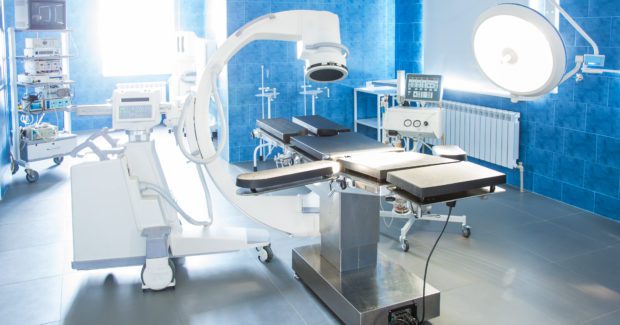Picture of Health (Part One)
An aging population, chronic disease and increasing access to medical services all create growing demands for cost-effective medical devices – and healthy business for OEMs and parts suppliers of complex components used in medical devices, surgical instruments, apparatus, artificial limbs, operating room and hospital equipment, dental equipment, X-ray machines and more.
Posted: October 31, 2018
The United States is the largest medical device market in the world, with a market size around $156 billion that represents about 40 percent of the global medical device market.1 The U.S. Department of Commerce reports that U.S. exports of medical devices last year exceeded $41 billion.1 A very large aging population, a long track record of chronic disease, and increasing access to medical services for sections of the population that were previously uninsured have all created growing demands for cost-effective medical devices that can meet the increasing needs for personal care, the cost constraints of an evolving healthcare system, and control of the rise in healthcare spending. These demands paint a strong picture of health for OEMs and parts suppliers doing business in the medical device industry, which is responsible for almost two million jobs in the U.S., including both direct and indirect employment.1 Medical technology accounts directly for well over 500,000 of these jobs, and more than 80 percent of medical device companies in the U.S. have fewer than 50 employees.1
Innovation fuels U.S. medical device manufacturing in an ongoing quest for better ways to treat and diagnose medical conditions and increase patient life expectancy. R&D represents a high percentage of medical device expenditures – averaging 7 percent of revenue – which reflects a highly competitive business that has introduced advances in neuro-stimulators, stent technologies, biomarkers, robotic assistance and implantable electronic devices, as well as microelectronics, telecommunications, instrumentation, biotechnology, and software development.1This heavy innovation requires OEMs and parts suppliers to respond quickly to new design specifications and regulations, different materials and higher component complexity as they manufacture instruments, apparatuses or machines used for prevention, diagnosis or treatment of illness or disease, or other equipment that detects, measures, restores, corrects or modifies a structure or function of the body.
To maintain and improve their profitability against increasing competition, both OEMs and parts suppliers are remaking themselves: In the past, contract shops were typically hired to produce parts needed by the next link in the supply chain. Now, many are remaking themselves into “one-stop-shop” suppliers that are more valuable to their customers by becoming involved with product development and process enhancement, and by acquiring technology solutions outside their traditional comfort zones. They are being rewarded with more dependable contracts from OEMs who are also trying to remake themselves by consolidating and streamlining their supply chains.2 More shops are adopting this “never rest, never stand still” attitude – an operating philosophy that traces its roots back to Micropulse, a job shop located in the “orthopedic capital of the world.”
References
- ““The Medical Technology Industry in the United States,” SelectUSA, U.S. Department of Commerce, October 11, 2018, www.selectusa.gov.
- “Medical Grows as Its End Market Slows,” Chris Koepfer, Modern Machine Shop, August 29, 2018, www.mmsonline.com.
To maintain and improve their profitability against increasing competition, both OEMs and parts suppliers are remaking themselves: In the past, contract shops were typically hired to produce parts needed by the next link in the supply chain. Now, many are remaking themselves into “one-stop-shop” suppliers that are more valuable to their customers by becoming involved with product development and process enhancement, and by acquiring technology solutions outside their traditional comfort zones. They are being rewarded with more dependable contracts from OEMs who are also trying to remake themselves by consolidating and streamlining their supply chains.2 More shops are adopting this “never rest, never stand still” attitude – an operating philosophy that traces its roots back to Micropulse Inc. (Columbia City, IN), a job shop located in the “orthopedic capital of the world.”
Multitasking Keeps a Pulse on New Medical Markets
Never rest, never stand still: A Schütte WU 305 Linear 5-axis universal tool and cutter grinder helped Micropulse enter the knee joint, hip broach and other end product market areas they could not compete in before.
The competitive attitude of “never rest, never stand still” applies to other parts suppliers that are trying to keep up with the latest manufacturing trends in the medical, pharmaceutical and dental market sectors of the healthcare industry. To help them improve on bidding for complex components used in medical devices, surgical instruments, apparatus, artificial limbs, operating room and hospital equipment, dental equipment, X-ray machines and more, here is some of the latest fabrication machinery, machine tools, tooling and accessories that can help them grow their business at profitable price levels by giving them higher tolerance capabilities to process new and difficult materials at reduced operating cycles for reliable deliveries:
Highly Productive Cutting of Small Gears for Medical Equipment
The Affolter AF110 plus gear hobbing center from Rotec Tools maximizes productivity in cutting small spur, helical, frontal, bevel, and crown gears for medical equipment, with cutter-spindle speeds up to 12,000 rpm.
Fine Wire Welding for Implantable Medical Devices, Hearing Aids, Orthodontics and More
The updated Series 320 Electronic Weld Head System from Amada Miyachi has increased maximum weld force to 7.0 lb, with a maximum follow up force of 7.75 lb to handle an even wider range of applications requiring precise position and force control.
Economic Upgrade of Small Vertical Machining Centers for Complex Medical Device Work
The ultra-high precision pL Lehmann 5-axis rotary table TAP from EXSYS Tool can upgrade a small vertical machining center to do complex medical device work up to a cube of approximately 5.9 in without the expense of a new machine.
Linear Encoders for Ultra-High Accuracy in Medical Machining
LIF 400 series linear encoders from Heidenhain improve contamination resistance with a position noise value of 0.6 Nm at one MHz and a low interpolation error down to ±12 Nm.
How to Meet Tough Finishing Demands on Pharmaceutical Projects
Instant Polish flap discs from Walter Surface Technologies boast powerful polishing properties and superior engineering that easily achieves No. 8 mirror finishes in a single step to save time and money.
Manufacturing Structurally Sophisticated Implants Without Supports
By integrating their Sapphire 3D printing system with Flow print preparation software and Intelligent Fusion technology, Velo3D can manufacture structurally sophisticated implants without supports to ensure better patient experience and lower cost.
Automatic Lathe Tooling to Make Screws and Pins for Medical Applications
The Citizen tool program from Heimatec that includes both live and static tools for most Citizen lathes incorporates the highest quality bearings, ground gear components, spindles, and housings to produce superior tools with maximum rigidity.
Non-Magnetic Bearings Prevent Static and Noise in Medical Equipment and More
Anticorrosive, chemical resistant, nonmagnetic and lubrication-free plastic bearings from Kashima are hand-machined to the highest precision standards to meet the varying and long-term demands of medical equipment.
Optical Surface Metrology Delivers New Insights into Surface Structures and Processing for Medical Applications
MarSurf CM systems from Mahr Inc. provide micron and nanometer resolution surface finish and micro-geometry information, including 2D and 3D surface roughness, bearing area, flatness, depth, volume and much more.
Scanning Slit Laser Beam Profilers for Medical Engineering
Ophir NanoScan 2s scanning slit profilers from MKS Instruments instantly measure beam position and size with sub-micron precision for CW and kHz-pulsed lasers by using moving slits to measure beam sizes from µm to mm at beam powers from µW to kW.
Hybrid Additive Manufacturing of Dissolvable Metal Components for Medical Implants
UNL is using a LENS 860 Hybrid Controlled Atmosphere system from Optomec for high quality additive and subtractive processing of magnesium to develop dissolvable components for next-generation medical implants.
Rigid Telescoping Tube Clamp with Quick-Release Handle for Medical Devices
The Telescoping Tube Clamp from Stafford provides superior holding power while letting users change the length of their nested tubing with infinite adjustability and locking without damaging the tube.
Simultaneous Control Compact 5-Axis Machining Center for Medical Equipment
The compact Xion Alpha 5-Axis simultaneous control machining center from Sugino is perfect for precision micro-machining of medical equipment and high speed, high quality machining of fine free-form surfaces on small diameter tools, impellers, turbine blades, lens molds and electronic parts weighing up to 15 kg.




